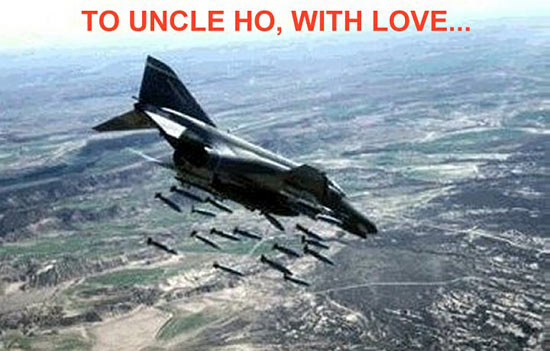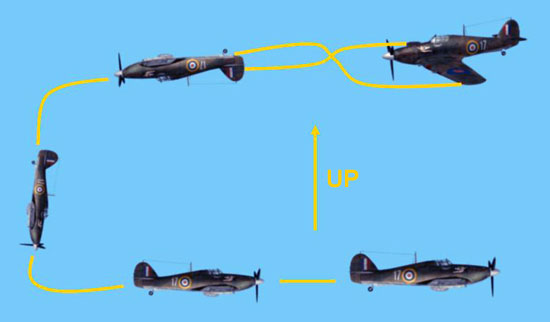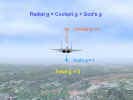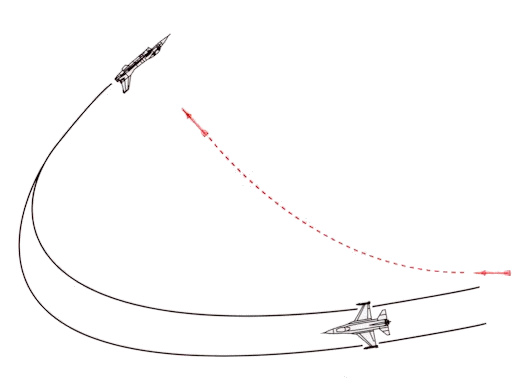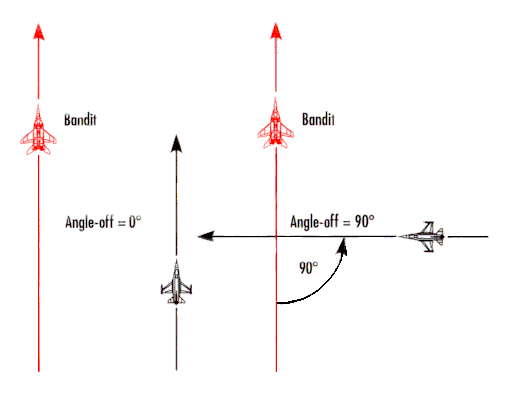by Andy Bush and Leon “Badboy” Smith
Counter-Offensive BFM – The Scissors
This article is about the maneuver known as the scissors. The format will be similar to our previous discussions. We’ll begin with an academic dissection of the scissors maneuver and then finish up with some recommendations on how to fly the maneuver in our sims. But, before we get into the meat of the matter, we need to set one thing straight.
For the purpose of this article, the scissors is a defensive BFM maneuver. There is no such thing as an offensive scissors. When flown as a defensive maneuver, the scissors is a response to an attacker’s position…the scissors is a result of an attacker’s failure to control overtake and/or angle off.
Why the emphasis? Simply because some folks seem to think that a scissors is a maneuver that you can initiate against an opponent. It’s the old “what came first…the chicken or the egg?” In this case…in our discussion…the answer is clear. The bandit’s position and maneuvering potential comes first…the scissors is only a counter to that bandit’s BFM error.
Our discussion will look at four questions. One, what is a scissors? Two, how does the defender begin the scissors? Three, how does the defender stay in the scissors? And, four, how does the defender get out of the scissors, if necessary?
Oh…and one more thing. Please be clear about one thing. When you commit yourself to a scissors, you have just jumped into the phone booth for a knife fight. Be ready for that. If you aren’t, then don’t scissors…it’s as simple as that.
Part One – Scissors Academics
In this section, we’ll lay out the background for the scissors maneuver. The scissors is far from the simple maneuver that some may see it as. In some respects, the scissors is a “last ditch” gambit. When entering a scissors, you are betting the ranch on your abilities in a slow speed fight. If that’s your game plan, then let’s do it armed with as much intel as we can absorb. Part One is that intel.
Section One – What Is A Scissors?
A scissors is a situation where two adversaries are attempting to gain an offensive advantage by turning to get behind each other. Since both adversaries are attempting the same outcome, the resultant maneuver flow looks like a series of flight path reversals. The result is typically a contest of who can fly the slowest.
Types of Scissors. There are two general types of scissors…flat and rolling. The flat scissors is an “in-plane” two-dimensional maneuver, while the rolling scissors is a three-dimensional maneuver.
Flat Scissors. The Flat Scissors is by far the most common form of this maneuver. The word “flat” refers to the orientation of the maneuver flow with the horizon…the flat scissors is flown more or less with the plane of motion (POM) being level with the horizon. In this maneuver, the pilot attempts to fly at minimum speed to produce the least forward movement and smallest turning radius relative to the other aircraft. The Flat Scissors is an “in-plane” maneuver in that both aircraft are flying “side to side” in the same general POM.
Rolling Scissors. The Rolling Scissors is probably the least commonly flown type of scissors. Unlike the flat scissors, the Rolling Scissors is a three-dimensional maneuver where each opponent flies “out-of-plane” with the other. The overall objective remains the same…limit forward velocity to force the other aircraft out front. While the flat scissors typically has its orientation defined by the horizon, the Rolling Scissors may be oriented at any angle to the horizon. This type of scissors may be visualized as two aircraft barrel rolling around each other’s flight path.
The Rolling Scissors has an additional element that is not as highly stressed in the flat scissors, and that is the importance of energy management. Since the Rolling Scissors is a series of climbing and diving turns, the importance of energy retention and management becomes critical. The pilot who can best preserve and use his energy will be the victor.
In this article, we are going to use the Flat Scissors as the focus of our discussion. Unless specifically mentioned, all further techniques, tips, and academic basics are based on flying the Flat Scissors!
The Scissors Is A Defensive Maneuver! Now that you have the general idea of what a scissors looks like, let’s talk about how you would get into one in the first place.
The scissors is the result of a defender trying to take advantage of an attacker’s overshoot. In other words…move – countermove. The overshoot is the move, and the scissors is the countermove. Think of it as a “stimulus – response” kind of thing. We need to get this idea down pat since everything that follows is based on the idea of recognizing and then acting effectively on a scissors opportunity.
Section Two – The Starting Point For A Scissors
The opportunity for a scissors begins with the attacker overshooting a defender’s flight path. This typically results from the defender making a hard or break turn into the attacker. The attacker is unable to stay within the defender’s turn radius and flies through or “overshoots” that turn radius. The usual reason for the attacker’s inability to match the defender’s turn radius (often referred to as “making the corner”) is excessive speed combined with too much angle off.
The Overshoot Has Three Components. These will be important for you to recognize later when we talk about how to fly the scissors in our sims.
These components are the attacker’s angle off, the rate that the attacker crosses your six, and his distance back when he overshoots your flight path. Remember these well and remember them in this order…angle off, rate, and distance back.
Angle Off. Angle off is the difference in headings between the defender and the attacker at the overshoot. When the defender looks back at the attacker, he compares the attacker’s fuselage alignment with his own. For this discussion, we’ll call any angle off less than 45 degrees “small”, and any angle off greater than 45 degrees “large”.
Rate. Here we are talking about the speed of the attacker as he crosses the defender’s six o’clock. It is not practical to refer to this in knots or mph…or in degrees/second. This rate of movement is a visual perception issue and is gained through experience. In this article, we’ll refer only to “fast” or “slow” rates.
Distance Back. When the attacker crosses the defender’s extended six, the separation between the two aircraft is the “distance back”. We won’t measure this in feet…instead, we’ll think in terms of the defender’s turn radius. “Close in” will be a distance less than that radius, and “far back” will be anything greater than that radius.
The Attacker’s Lift Vector – How He Signals His Intentions. At this point, we have an attacker who seems to be overshooting our six. We want to know if we can or should reverse…or continue our defensive turn. We mentioned the three components of the overshoot, but let’s stop for a moment and remind ourselves that the attacker may not allow himself to overshoot. Is an overshoot good BFM? No…probably not. Typically, an overshoot would be a BFM error for the attacker. If he was smart…and saw the overshoot coming…he would be wise to do something to prevent it from happening…or at least minimize it. That’s what you would do…right??!!
So…what would you do? Yo-yo off, you say! Correct. A High Yo-Yo is a good maneuver to use in this situation. An attacker doesn’t have to continue blowing through your flight path. He may roll out and yo-yo off to preserve his offensive position.
The key thing for us to focus on now is those words “roll out”. As the attacker comes in, he’s trying to match your turn. That means his bank angle is about the same as yours…he has his lift vector more or less aligned with your POM.
But if he decides to yo-yo off, he must roll away from your bank angle to orient his lift vector out of your POM. If he does this, it will be very obvious to you. If his lift vector is pointed away from your POM, he is signaling his intention to yo-yo.
This is a crucial point for the defender. What should he do now? The attacker is maneuvering out of plane. Is it possible to reverse now? Can the defender scissors with a bandit that is repositioning in the vertical?
The answer is a qualified yes…a definite maybe! The defender better have a bunch of energy! It is possible for the defender to perform a climbing reversal. The result is often a rolling scissors. What I suggest, however, is that we keep it simple at this point. In most cases, the defender may not have that level of energy. It probably will not be possible or practical for him to reverse in this situation. So, here is a rule of thumb for most situations.
Consider a reversal only if the attacker’s lift vector remains aligned with your POM in the overshoot. If the attacker rotates his lift vector out of your POM, he is signaling a yo-yo. Your better response to this is one of two things. Either continue your defensive turn…or immediately unload and extend for separation. The extension is the traditional BFM counter to a yo-yo. Unload and extend to get some of your energy back, increase your separation, and set up your next defensive move.
So much for the yo-yo…let’s get back to handling the overshoot. Your next move is the reversal. There are a number of considerations to keep in mind.












